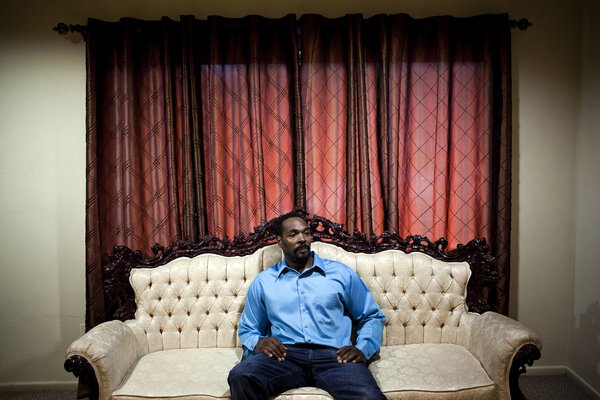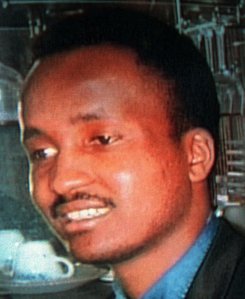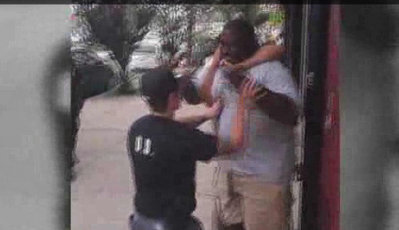Controversial police use-of-force cases
By Maria L. La Ganga and Tina Susman
Here are several cases that generated controversy, sometimes protests and sometimes independent investigations, including by the Justice Department.
James Boyd

James Boyd, a 38-year-old mentally ill homeless man who suffered from delusions, was camping illegally in the Sandia Foothills on March 16 of this year when Albuquerque police officers tried to arrest him.
During a standoff, Boyd waved two knives, and 41 officers from various agencies surrounded him. “Finally, when Mr. Boyd appeared to be surrendering, officers threw a flash bang at him, released a dog to take him down, and shot him with a taser rifle,” according to a wrongful death suit filed against the city. “As Mr. Boyd turned away from the officers, two officers shot three rounds each, hitting him three times, twice in his side and back and once on his arm.”
The incident was recorded on one officer’s helmet cam.
Boyd’s last words on the recording were, “Please don’t hurt me,” and “I can’t move.” Boyd was taken by ambulance to the University of New Mexico Hospital. His right arm was amputated and his spleen and intestine were removed. He died at 2:55 a.m. on March 17.
Four days later, Albuquerque police Chief Gorden Eden released video of the incident. He told reporters that Boyd had made “violent threats” against the officers, who first used “less-than-lethal” weapons to arrest him. “The officers perceived a direct threat to the canine handler when the shots were fired,” Eden said. “Do I believe it was a justified shooting? Yes. If you follow case law…there was a directed threat to an officer.”
More than a year before Boyd’s death, the U.S. Department of Justice began investigating whether there was a pattern of excessive force used by members of the Albuquerque Police Department, actions that violate the Constitution and federal law. On April 10 of this year, the DOJ found Albuquerque officers “too frequently use deadly force against people who pose a minimal threat and in situations where the conduct of the officers heightens the danger.”
Photo: James Boyd lies face down after being shot. Credit: Albuquerque Police Department
Eula Love

On Jan. 3, 1979, Eula Love was shot eight times in her front yard by two Los Angeles Police Department patrol officers. Gas company employees had sought the patrol officers’ help in collecting an overdue bill from the 39-year-old widow, or in shutting off her gas service. The officers emptied their revolvers at Love in what they described as self defense because she was about to throw a knife at them.
After a lengthy inquiry into Love’s death, the district attorney’s Special Investigations Division decided not to file charges against the officers, sparking widespread public outrage.
Photo credit: Los Angeles Times
Rodney King

Rodney King, who had long struggled with drugs and alcohol, was drunk and unarmed on March 3, 1991, when he was pulled over for speeding by Los Angeles police officers and brutally beaten.
The incident was captured on video by a civilian bystander, and the recording made the incident known worldwide.
Four of the officers involved, who were white, were tried for excessive force. They were acquitted on April 29, 1992, touching off one of the worst urban riots in U.S. history. There were 54 riot-related deaths and nearly $1 billion in property damage.
Photo: Rodney King in March 2012, a few months before he died. Credit: Jay L. Clendenin / Los Angeles Times
Amadou Diallo

On Feb. 4, 1999, four plainclothes New York City police officers opened fire on Amadou Diallo, killing the unarmed 23-year-old. Police said Diallo matched the description of a suspected serial rapist.
A grand jury indicted the officers on charges of second-degree murder and reckless endangerment. A jury acquitted them of all charges. The officers said they feared that Diallo was armed and reaching for a gun when he put his hand into his pocket to pull out his wallet. The officers fired a total of 41 shots, 19 of which hit Diallo.
Photo credit: Associated Press
Danroy Henry Jr.
On Oct., 17, 2010, Danroy Henry Jr., a 20-year-old student at Pace University in Pleasantville, N.Y., was shot to death by a police officer outside a bar in a suburb north of New York City.
Henry was in his car and pulling away from the curb when he was shot. Police had been called to the scene after reports of a rowdy crowd on the sidewalk outside the bar, where students had gathered after a football game. Two officers opened fire on Henry’s car. Both said he had refused their orders to stop, and one said he fired in self-defense to avoid being run over. Other students said Henry was not trying to run down the police but was trying to move his car from a fire lane where it was illegally standing.
A grand jury declined to indict the officers.
Kelly Thomas

The case of Kelly Thomas — a 37-year-old homeless schizophrenic man whose July 2011 beating death sparked months of protests and the recall of three Fullerton city councilmen — was the first in Orange County’s history that involved an officer facing murder charges for on-duty actions.
Orange County Dist. Atty. Tony Rackauckas argued the case himself in court. The trial played out for nearly three weeks. After two days of deliberations, the jury found the two police officers not guilty of all charges.
Thomas was beaten unconscious as he cried out for help. He died five days after being admitted to the hospital comatose, with multiorgan failure, multiple fractures to his face and ribs and signs of having suffered respiratory and cardiac arrest.
A third officer was charged with involuntary manslaughter, but prosecutors decided not to pursue that case after the two losing verdicts.
Photo credit: Associated Press
Ramarley Graham

Ramarley Graham was 18 when police entered his Bronx apartment without a warrant and shot him inside a bathroom on Feb. 2, 2012. Video captured by surveillance cameras on his building showed Graham walking into the building, then police officers going to the building’s door and kicking it in. They then ran upstairs to Graham’s apartment. One of them shot Graham once in the chest.
The officer said he thought Graham was armed, based on conversations he said he heard on his police radio. A bag of marijuana was found near Graham, but no weapon.
A manslaughter indictment against the officer who shot Graham was thrown out by a judge on a technicality. A second grand jury failed to indict.
Photo credit: NDN
Eric Garner

On July 17 of this year, 43-year-old Eric Garner died after a police officer in Staten Island placed him in an illegal chokehold during an encounter on the sidewalk, where officers accused Garner of illegally selling cigarettes. A bystander shot video showing Garner’s final moments, including his repeatedly saying “I can’t breathe” as the officer’s arm was put around his neck.
The city’s medical examiner ruled Garner’s death a homicide due to compression of the neck and chest. Two officers face an internal investigation in connection with Garner’s death. The one who applied the chokehold was put on modified duty, meaning he was stripped of his gun and badge.
A grand jury continues to hear evidence to determine if the police involved should be indicted.
Photo credit: NDN
Dillon Taylor

On Aug. 11 of this year, police in Salt Lake City responded to a call of a possibly armed man at a convenience store. When Officer Bron Cruz arrived, he saw two men leaving the market. They put their hands in the air. The third man, Dillon Taylor, 20, did not. After a brief standoff, during which Taylor continued to walk with his hands at his waistband, Cruz killed Taylor with two shots.
The officer said he feared Taylor had a gun and was preparing to open fire. The district attorney ruled in September that based on police accounts and on footage captured by Cruz’s dashboard camera, the shooting was justified.
Photo credit: NDN
Ezell Ford

Ezell Ford, 25, was shot to death by police Aug. 11 this year in South L.A.’s Florence neighborhood. Witnesses and others questioned the LAPD’s account of the killing — which held that Ford attacked an officer and tried to take his weapon — saying that Ford was complying with officers or that officers had been warned about his mental illness.
Los Angeles Mayor Eric Garcetti announced recently that he had ordered police to allow the release soon of an autopsy report on Ford. LAPD officials have placed a security hold on the autopsy results, preventing coroner’s officials from making their report public.